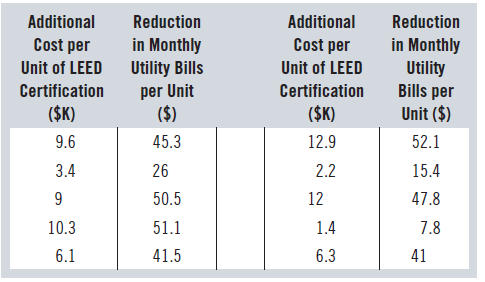Leadership in Energy and Environmental Design (LEED) is a program that certifies that buildings meet a range
Question:
Leadership in Energy and Environmental Design (LEED) is a program that certifies that buildings meet a range of energy and environmental efficiency standards, including extra insulation to reduce energy consumption for heating and cooling the building and efficient water use. Meeting these standards adds to the capital cost of the building but reduces the operating costs (e.g., utility bills for energy and water). LEED certified condominiums sell at a higher price than comparable regular condos, but cost less in monthly utility bills. A property developer is building 10 condo buildings in Toronto and estimates the additional cost per unit of making them LEED certified, together with the reduction in monthly energy and water bills that can be expected as a result:

a) Check the conditions for using a linear model to represent this data.
b) Which variable should be the explanatory variable from which the other is estimated? Give your reasons.
c) Transform the additional cost by taking its logarithm to the base 10, and then fit a linear model, commenting on the conditions.
d) If the unit cost increases by $5.2K as a result of obtaining LEED certification, what do you predict would be the reduction in utility bills per unit?
e) What fraction of the variability in the transformed data is accounted for by this model?
f) Interpret the meaning of the slope coefficient in this model.
Step by Step Answer:

Business Statistics
ISBN: 9780133899122
3rd Canadian Edition
Authors: Norean D. Sharpe, Richard D. De Veaux, Paul F. Velleman, David Wright





